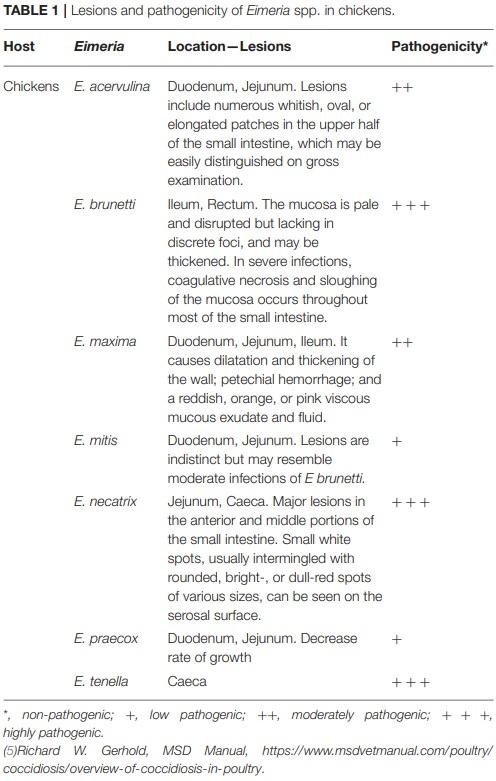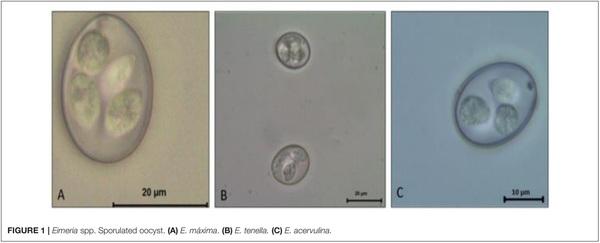Overview of Poultry Eimeria Life Cycle and Host-Parasite Interactions


1. Chapman HD. Milestones in avian coccidiosis research : a revieww citing articles via. Poult Sci. (2014) 93:501–11. doi: 10.3382/ps.2013-03634
2. Quiroz-Castañeda RE, Dantán-González E. Control of avian coccidiosis: future and present natural alternatives. Biomed Res Int. (2015) 2015:430610. doi: 10.1155/2015/430610
3. Haug A, Gjevre AG, Skjerve E, Kaldhusdal M. A survey of the economic impact of subclinical eimeria infections in broiler chickens in Norway. Avian Pathol. (2008) 37:333–41. doi: 10.1080/03079450802050705
4. Conway DP, McKenzie ME. Poultry Coccidiosis-Diagnostic and Testing Procedure. Blackwell Publishing (2007). doi: 10.1002/9780470344620
5. Hafez HM. Poultry coccidiosis: prevention and control approaches. Arch Geflugelkd. (2008) 72:2–7. Available online at: https://www.europeanpoultry-science.com/artikel.dll/m07-63mk_NDIxODc3OQ.PDF?UID= A93A7FD91505A7194EAEA87681193EC80827091F95A8BC
6. Tewari AK, Maharana BR. Control of poultry coccidiosis: changing trends. J Parasit Dis. (2011) 35:10–7. doi: 10.1007/s12639-011-0034-7
7. Lang M, Kann M, Zahner H, Taubert A, Hermosilla C. Inhibition of host cell apoptosis by eimeria bovis sporozoites. Vet Parasitol. (2009) 160:25– 33. doi: 10.1016/j.vetpar.2008.10.100
8. Kendall DJ. Species properties of coccidia of domestic animals. In: Life Cycles of Coccidia of Domestic Animals. Oxford, UK: ButterworthHeinemann; Elsevier (1972). p. 197–237. doi: 10.1016/B978-0-8391-0066-9.5 0011-6
9. Chartier C, Paraud C. Coccidiosis due to Eimeria in sheep and goats, a review. Small Rumin Res. (2012) 103:84–92. doi: 10.1016/j.smallrumres.2011. 10.022
10. Price KR. Use of live vaccines for coccidiosis control in replacement layer pullets. J Appl Poult Res. (2012) 21:679–92. doi: 10.3382/japr.2011-00486
11. Khazandi M. Title The Eimeria-Host Cell Interaction in Broiler Chickens. Roseworthy, SA: University of Adelaide (2006).
12. Deplazes P, Eckert J, Mathis A, Samson-Himmelstjerna G. von Zahner H. Parasitology in Veterinary Medicine. Wageningen: Wageningen Academic Publishers (2016). doi: 10.3920/978-90-8686-274-0
13. Müller J, Hemphill A. In vitro culture systems for the study of apicomplexan parasites in farm animals. Int J Parasitol. (2013) 43:115– 24. doi: 10.1016/j.ijpara.2012.08.004
14. Allen PC, Fetterer RH. Recent advances in biology and immunobiology of eimeria species and diagnosis and control of infection with these coccidian parasites of poultry. Clin Microbiol Rev. (2002) 15:58–65. doi: 10.1128/CMR.15.1.58-65.2002
15. Augustine PC. Cell: sporozoite interactions and invasion by apicomplexan parasites of the genus eimeria. Int J Parasitol. (2001) 31:1–8. doi: 10.1016/S0020-7519(00)00150-8
16. Bowman D. Georgis’Parasitology for Veterinarians. St. Louis, MO: Elsevier (2014).
17. Ryley JF. Biochemistry of coccidia. Comp Biochem Parasites. New York, NY; London: Academic Press (1972) 359– 81. doi: 10.1016/B978-0-12-711050-9.50030-0
18. Pyziel AM, Demiaszkiewicz AW. Observations on sporulation of eimeria bovis (Apicomplexa: Eimeriidae) from the European bison bison bonasus: effect of temperature and potassium dichromate solution. Folia Parasitol. (2015) 62:1–3. doi: 10.14411/fp.2015.020
19. Chapman HD. Studies on the excystation of different species of eimeria in vitro. Zeitschrift Parasitenkd Parasitol Res. (1978) 56:115– 21. doi: 10.1007/BF00930742
20. Müller J, Hemphill A. In vitro culture systems for the study of apicomplexan parasites in farm animals. Int J Parasitol. (2013) 43:115– 24. doi: 10.1016/j.ijpara.2012.08.004
21. López-Osorio S, Silva LMR, Chaparro-Gutierréz JJ, Velásquez ZD, Taubert A, Hermosilla C, et al. Optimized excystation protocol for ruminant eimeria bovis- and eimeria arloingi-sporulated oocysts and first 3D holotomographic microscopy analysis of differing sporozoite egress. Parasitol Int. (2020) 76:102068. doi: 10.1016/j.parint.2020.102068
22. Andrews J. Excystation of coccidial oocyst in vivo. Science. (1930) 71:37. doi: 10.1126/science.71.1828.37
23. Nyberg PA, Hammond DM. Excystation of eimeria bovis and other species of bovine coccidia∗ . J Protozool. (1964) 11:474–80. doi: 10.1111/j.1550-7408.1964.tb 01781.x
24. Woodmansee DB. Isolation, in vitro excystation, and in vitro development of Cryptosporidium sp. from calves (Ph.D. Thesis), Iowa State University, Ames, IA, United States (1986).
25. Hibbert L, Hammond D, Simmons J. The effects of pH, buffers, bile and bile acids on excystation of sporozoites of various eimeria species. J Protozool. (1968) 16:441–4. doi: 10.1111/j.1550-7408.1969.tb02297.x
26. Levine DN. Protozoan Parasites of Domestic Animals and Man. Mineapolis, MN: Burguess Publishing Company (1973).
27. Levine DN. Apicomplexa: The Coccidia Proper. Protozoan Parasites of Domestic Animals and Man. Burgress Publishing Company (1973).
28. Tierney J, Mulcahy G. Comparative development of eimeria tenella (Apicomplexa) in host cells in vitro. Parasitol Res. (2003) 90:301– 4. doi: 10.1007/s00436-003-0846-1
29. Bedrnik P. Cultivation of eimeria tenella in tissue culture. further development of second generation of merozoites in tissue cultures. Acta protozool. (1969) 7:87–98.
30. Hammond D, Ernst J, Goldman M. Cytological observations on eimeria bovis merozoites. J Parasitol. (1965) 51:852–8. doi: 10.2307/ 3276176
31. Hammond DM, Long PL. The Coccidia. Eimeria, Isospora, Toxoplasma, and Related Genera. Baltimore, London: University Park Press (1973).
32. Madden PA, Vetterling JM. Scanning electron microscopy of eimeria tenella microgametogenesis and fertilization. J Parasitol. (1977) 63:607– 10. doi: 10.2307/3279559
33. Hammond DM, Andersen FL, Miner M. The ocurrence of a second asexual generation in the life cycle of E.bovis in calfs. J Parasitol. (1963) 49:428– 34. doi: 10.2307/3275812
34. Walton A. No title. J Parasit. (1959) 45:1–20. doi: 10.2307/3274781
35. Waldenstedt L, Elwinger K, Lundén A, Thebo P, Uggla A. Sporulation of eimeria maxima oocysts in litter with different moisture contents. Poult Sci. (2001) 80:1412–5. doi: 10.1093/ps/80.10.1412
36. Kim K, Weiss LM. Toxoplasma gondii: the model apicomplexan. Int J
Parasitol. (2004) 34:423–32. doi: 10.1016/j.ijpara.2003.12.009
37. Foquet L, Hermsen CC, Verhoye L, van Gemert GJ, Cortese R, Nicosia A, et al. Anti-CD81 but not anti-SR-BI blocks plasmodium falciparum liver infection in a humanized mouse model. J Antimicrob Chemother. (2014)
70:1784–7. doi: 10.1093/jac/dkv019
38. Kemp LE, Yamamoto M, Soldati-Favre D. Subversion of host cellular functions by the apicomplexan parasites. FEMS Microbiol Rev. (2013)
37:607–31. doi: 10.1111/1574-6976.12013
39. Friedrich N, Matthews S, Soldati-Favre D. Sialic acids: key determinants for invasion by the apicomplexa. Int J Parasitol. (2010) 40:1145–
54. doi: 10.1016/j.ijpara.2010.04.007
40. Augustin P. Cell: sporozoite interactions and invasion by apicomplexan parasites of the genus eimeria. Int J Parasitol. (2001)
31:1–8. doi: 10.1016/S0020-7519(00)00150-8
41. Marquerdt W. Attempted transmission of the rat coccidium Enieschulzi to mice. J Parasit. (1966) 52:691–4. doi: 10.2307/3276432
42. Khazandi M, Tivey D. Developing an in vitro method for eimeria tenella attachment to its preferred and non-preferred intestinal sites. Exp Parasitol. (2010) 125:137–40. doi: 10.1016/j.exppara.2010.01.007
43. Hammond DM, Long PL. The coccidia. Baltimore University (1973). p. 481.
44. Augustine P. A study of the invasion of cells by eimeria sporozoites using monoclonal antibodies generated against sporozoites and host cells.
In: McDougald L, Long P, editors. Proceedings of the Georgia Coccidiosis
Conference. (1986). p. 602–8.
45. Joyner L. Host and site specificity. In: Long P, editor. The Biology of the
Coccidia, University Park Press: Baltimore, MD. 35–62. (1982).
46. Bumstead J, Tomley F. Use of in vitro culture to examine the role of microneme proteins in host cell invasion by eimeria tenella. In: Shirley
M, Tomley F, Freeman B, editors. Control of Coccidiosis Into the Next
Millennium. Berks, UK: Institute for Animal Health (1997). p. 77.
47. Nichols B, Chiappino M, O’Conner G. Secretion from the rhopties of toxoplasma gondii during host cell invasion. J Ultrastruct Res. (1983) 83:85–
98. doi: 10.1016/S0022-5320(83)90067-9
48. Dolbrowolski J, Sibley L. Toxoplasma invasion of mammalian cells is powered by the actin cytoskeleton of the parasite. Cell. (1996) 84:933–
9. doi: 10.1016/S0092-8674(00)81071-5
49. Tierney JB, Matthews E, Carrington SD, Mulcahy G. Interaction of eimeria tenella with intestinal mucin in vitro. J Parasitol. (2007) 93:634–
38. doi: 10.1645/GE-1066R.1
50. Fayer R. Quinine inhibition of host cell penetration by eimerian sporozoites in vitro. J Parasitol. (1971) 57:901–5. doi: 10.2307/3277825
51. Augustine P. Host-parasite interactions at the cell surface. In: St John J, Berlin
E, editors. Frontiers of Membrane Research in Agriculture. Beltsville, MD:
Rowman and Allenheld (1985). p. 461–6.
52. Augustine P. Eimeria meleagrimitis sporozoites: effects of lectins on invasion of cultured cells. Poult Sci. (1985) 64:2296–9. doi: 10.3382/ps.
0642296
53. Augustine P, Danforth H. A study of the dynamics of invasion of immunised birds by Eimeria sporozoites. Avian Dis. (1986) 30:196–
212. doi: 10.2307/1590540
54. Augustine P, Danforth H. Use of monoclonal antibodies to study surface antigens of Eimeria sporozoites. In: Proc. Helm. Soc. Washington, DC (1987). p. 207–211.
55. Fuller AL, McDougald LR. Reduction in cell entry of eimeria tenella (Coccidia) sporozoites by protease inhibitors, and partial characterization of proteolytic activity associated with intact sporozoites and merozoites. J
Parasitol. (1990) 76:464–7. doi: 10.2307/3282822
56. Crane M, McGaley C. Eimeria tenella: inhibition of host cell invasion by phospholipase treatment of sporozoites. Exp Parasitol. (1991) 72:219–
22. doi: 10.1016/0014-4894(91)90140-R
57. Augustine P. Molecular interactions of cultured turkey kidney cells with specific antigens of Eimeria adenoeides sporozoites.
Proc Exp Biol Med. (1989) 191:30–6. doi: 10.3181/00379727-191-
42885
58. Carruthers V, Hakansson S, Giddings O, Sibley L. Toxoplasma gondii uses sulfated proteoglycans for substrate and host cell attachment. Infect Immun. (2000) 68:4005–11. doi: 10.1128/IAI.68.7.4005-4011.2000
59. Naguleswaran A, Muller N, Hemphill A. Neospora caninum and toxoplasma gondii: a novel adhesion/invasion assay reveals distinct differences in tachyzoite–host cell interactions. Exp Parasitol. (2003) 104:149–
58. doi: 10.1016/S0014-4894(03)00137-1
60. Vonlaufen N, Guetg N, Naguleswaran A, Müller N, Björkman C, Schares
G, et al. In vitro induction of neospora caninum bradyzoites in vero cells reveals differential antigen expression, localization, and host-cell recognition of tachyzoites and bradyzoites. Infect Immun. (2004) 72:576–
83. doi: 10.1128/IAI.72.1.576-583.2004
61. Alroy J, Goyal V, Lukacs NW, Taylor RL, Strout RG, Ward HD, et al.
Glycoconjugates of the intestinal epithelium of the domestic fowl (gallus domesticus): a lectin histochemistry study. Histochem J. (1989) 21:187–
93. doi: 10.1007/BF01747519
62. Suprasert A, Fujioka T. Lectin and ultrastructural biochemistry of glycoconjugates in the caecal epithelium of the chicken. Acta Histochem. (1988) 83:141–51. doi: 10.1016/S0065-1281(88)80047-3
63. Fayer R, Hammond D. Development of first generation schizonts of eimeria bovis in cultured bovine cells. J Protozool. (1967) 14:1104–
5. doi: 10.1111/j.1550-7408.1967.tb02076.x
64. Hermosilla C, Barbisch B, Heise A, Kowalik S, Zahner H.
Development of eimeria bovis in vitro: suitability of several bovine, fetal gastrointestinal, madin-darby bovine kidney (MDBK) and
African green monkey kidney (VERO) cells. Parasitol Res. (2002)
88:301–7. doi: 10.1007/s00436-001-0531-1
65. Bumstead J, Tomley F. Induction of secretion and surface capping of microneme proteins in eimeria tenella. Mol Biochem Parasitol. (2000)
110:311–21. doi: 10.1016/S0166-6851(00)00280-2
66. Russell D, Sinden R. The role of the cytoskeleton in the motility of coccidian sporozoites. J Cell Sci. (1981) 50:345–59.
67. Sibley LD. How apicomplexan parasites move in and out of cells. Curr Opin
Biotechnol. (2010) 21:592–8. doi: 10.1016/j.copbio.2010.05.009
68. Doran D. The Behavior of Coccidia in vitro the Coccidia. Baltimore, MD;
London: University Park Press (1982).
69. Carruthers V, Sibley L. Sequential protein secretion from three distinct organelles of toxoplasma gondii accompanies invasion of human fibroblasts.
Eur J Cell Biol. (1997) 73:114–23.
70. Mordue D, Desai N, Dustin M, Sibley L. Invasion by toxoplasma gondii establishes a moving junction that selectively excludes host cell plasma membrane proteins on the basis of their membrane anchoring. J Exp Med. (1999) 190:1783–92. doi: 10.1084/jem.190.12.1783
71. Nichols B, Chiappino M. Cytoskeleton of toxoplasma gondii. J Protozool. (1987) 34:217–26. doi: 10.1111/j.1550-7408.1987.tb03162.x
72. Nichols B, O’Connor G. Penetration of mouse peritoneal macrophages by the protozoon toxoplasma gondii. New evidence for active invasion and phagocytosis. Lab Invest. (1981) 44:324–35.
73. Morrissette N, Sibley L. Cytoskeleton of apicomplexan parasites. Microbiol
Mol Biol Rev. (2002) 66:21–38. doi: 10.1128/MMBR.66.1.21-38.2002
74. Augustine PC. Cell: sporozoite interactions and invasion by apicomplexan parasites of the genus eimeria. Int J Parasitol. (2001)
31:1–8. doi: 10.1016/S0020-7519(00)00150-8
75. Melo M, Jensen K, Saeij J. Toxoplasma gondii effectors are master regulators of the inflammatory response. Trends Parasitol. (2011) 27:487–
95. doi: 10.1016/j.pt.2011.08.001
76. Keeley A, Soldati D. The glideosome: a molecular machine powering motility and host-cell invasion by Apicomplexa. Trends Cell Biol. (2004) 14:528–
32. doi: 10.1016/j.tcb.2004.08.002
77. Meissner M, Ferguson DJ, Frischknecht F. Invasion factors of apicomplexan parasites: essential or redundant? Curr Opin Microbiol. (2013) 16:438–
44. doi: 10.1016/j.mib.2013.05.002
78. Lourido S, Moreno SNJ. The calcium signaling tooklkit of the apicomplexan parasites toxoplasma gondii and plasmodium spp. Cell Calcium. (2015)
57:186–93. doi: 10.1016/j.ceca.2014.12.010
79. Lavine MD, Arrizabalaga G. Exit from host cells by the pathogenic parasite toxoplasma gondii does not require motility. Eukaryot Cell. (2008) 7:131–
40. doi: 10.1128/EC.00301-07
80. Harker KS, Ueno N, Lodoen MB. Toxoplasma gondii dissemination: a parasite’s journey through the infected host. Parasite Immunol. (2015)
37:141–9. doi: 10.1111/pim.12163
81. Blackman MJ, Carruthers VB. Recent insights into apicomplexan parasite egress provide new views to a kill. Curr Opin Microbiol. (2013) 16:459–
64. doi: 10.1016/j.mib.2013.04.008
82. Tardieux I, Menard R. Migration of Apicomplexa across biological barriers: the toxoplasma and plasmodium rides. Traffic. (2008) 9:627–
35. doi: 10.1111/j.1600-0854.2008.00703.x
83. Opitz C, Soldati D. The glideosome: a dynamic complex powering gliding motion and host cell invasion by toxoplasma gondii. Mol Microbiol. (2002)
45:597–604. doi: 10.1046/j.1365-2958.2002.03056.x
84. Foth BJ, Goedecke MC, Soldati D. New insights into myosin evolution and classification. Proc Natl Acad Sci USA. (2006)
103:3681–6. doi: 10.1073/pnas.0506307103
85. Pinder JC, Fowler RE, Dluzewski AR, Bannister LH, Lavin FM, Mitchell
GH, et al. Actomyosin motor in the merozoite of the malaria parasite. plasmodium falciparum: implications for red cell invasion. J Cell Sci. (1998) 111:1831–9.
86. Schwartzman JD, Pfefferkorn ER. Immunofluorescent localization of myosin at the anterior pole of the coccidian, toxoplasma gondii. J Protozool. (1983)
30:657–61. doi: 10.1111/j.1550-7408.1983.tb05339.x
87. Boucher LE, Bosch J. The apicomplexan glideosome and adhesins – structures and function. J Struct Biol. (2015)
190:93–114. doi: 10.1016/j.jsb.2015.02.008
88. Tyler JS, Treeck M, Boothroyd JC. Focus on the ringleader: the role of
AMA1 in apicomplexan invasion and replication. Trends Parasitol. (2011)
27:410–20. doi: 10.1016/j.pt.2011.04.002
89. Morahan BJ, Wang L, Coppel RL. No TRAP, no invasion. Trends Parasitol. (2009) 25:77–84. doi: 10.1016/j.pt.2008.11.004
90. Carruthers VB, Tomley FM. Microneme proteins in apicomplexans. Subcell
Biochem. (2008) 47:33–45. doi: 10.1007/978-0-387-78267-6_2
91. Sheetz M, Painter R, Singer S. Biological membranes as bilayer couples III. compensatory shape changes induced in membranes. J Cell Biol. (1976)
70:193–206. doi: 10.1083/jcb.70.1.193
92. Sibley L. Toxoplasma gondii: perfecting an intracellular life style. Traffic. (2003) 4:581–6. doi: 10.1034/j.1600-0854.2003.00117.x
93. Sinai A, Webster P, Joiner K. Association of host cell endoplasmic reticulum and mitochondria with the Toxoplasma gondii parasitophorous vacuole membrane: a high affinity interaction. J Cell Sci. (1997) 110:2117–28.
94. Hakansson S, Charron A, Sibley L. Toxoplasma evacuoles: a two-step process of secretion and fusion forms the parasitophorous vacuole. Herm-Gotz. Eur
Mol Biol Org J. (2001) 20:3132–44. doi: 10.1093/emboj/20.12.3132
95. Sinai AP, Joiner KA. The toxoplasma gondii protein ROP2 mediates host organelle association with the parasitophorous vacuole membrane. J Cell
Biol. (2001) 154:95–108. doi: 10.1083/jcb.200101073
96. Melo EJ, Carvalho TM, De Souza W. Behaviour of microtubules in cells infected with Toxoplasma gondii. Biocell. (2001) 25:53–9.
97. Jones TC, Hirsch JG. The interaction between toxoplasma gondii and mammalian cells: II. The absence of lysosomal fusion with phagocytic vacuoles containing living parasites. J Exp Med. (1972) 136:1173–
94. doi: 10.1084/jem.136.5.1173
98. Coppens I, Dunn JD, Romano JD, Pypaert M, Zhang H, Boothroyd JC, et al.
Toxoplasma gondii sequesters lysosomes from mammalian hosts in the the vacuolar space. Cell. (2006) 125:261–74. doi: 10.1016/j.cell.2006.01.056
99. de Melo EJ, de Carvalho TU, de Souza W. Penetration of toxoplasma gondii into host cells induces changes in the distribution of the mitochondria and the endoplasmic reticulum. Cell Struct Funct. (1992)
17:311–17. doi: 10.1247/csf.17.311
100. Labesse G, Gelin M, Bessin Y, Lebrun M, Papoin J, Cerdan R, et al. ROP2 from toxoplasma gondii: a virulence factor with a protein-kinase fold and no enzymatic activity. Eukaryot Cell. (2009)
10:483–93. doi: 10.1016/j.str.2008.11.005
101. Coppens I. Exploitation of auxotrophies and metabolic defects in toxoplasma as therapeutic approaches. Int J Parasitol. (2014) 44:109–
20. doi: 10.1016/j.ijpara.2013.09.003
102. Blader IJ, Koshy A. Toxoplasma gondii development of its replicative niche : in its host cell and beyond. Eukaryotic Cell. (2014) 13:965–
76. doi: 10.1128/EC.00081-14
103. Caamano J, Hunter C. NF-κB family of transcription factors: central regulators of innate and adaptive immune functions. Clin Microbiol Rev. (2002) 15:414–29. doi: 10.1128/CMR.15.3.414-429.2002
104. Butcher B, Kim L, Johnson P, Denkers E. Toxoplasma gondii tachyzoites inhibit proinflammatory cytokine induction in infected macrophages by preventing nuclear translocation of the transcription factor NF-kappa
65. B J Immunol. (2001) 167:2193–201. doi: 10.4049/jimmunol.167.4.
2193
105. Chen X. Cryptosporidium parvum activates nuclear factor kappaB in biliary epithelia preventing epithelial cell apoptosis. Gastroenterology. (2001)
120:1774–83. doi: 10.1053/gast.2001.24850
106. Molestina R, Payne T, Coppens I, Sinai A. Activation of NF-kappaB by toxoplasma gondii correlates with increased expression of antiapoptotic genes and localization of phosphorylated IkappaB to the parasitophorous vacuole membrane. J Cell Sci. (2003) 116:4359–71. doi: 10.1242/jcs.
00683
107. Caamano J. Identification of a role for NF-kappa B2 in the regulation of apoptosis and in maintenance of T cell-mediated immunity to toxoplasma gondii. J Immunol. (2000) 165:5720–28. doi: 10.4049/jimmunol.165.
10.5720
108. Tripathi A, Sullivan D, Stins M. Plasmodium falciparum-infected erythrocytes increase intercellular adhesion molecule 1 expression on brain endothelium through NF-κB. Infect Immun. (2006)
74:3262–70. doi: 10.1128/IAI.01625-05
109. Ong Y, Reese M, Boothroyd J. Toxoplasma rhoptry protein 16 (ROP16) subverts host function by direct tyrosine phosphorylation of STAT6. J Biol Chem. (2010) 285:28731–40. doi: 10.1074/jbc.M110.
112359
110. Lieberman L, Banica M, Reiner S, Hunter C. STAT1 plays a critical role in the regulation of antimicrobial effector mechanisms, but not in the development of Th1-type responses during toxoplasmosis. J Immunol. (2004) 172:457–
63. doi: 10.4049/jimmunol.172.1.457
111. Gavrilescu LC, Butcher BA, Del Rio L, Taylor GA, Denkers EY. STAT1 is essential for antimicrobial effector function but dispensable for gamma interferon production during toxoplasma gondii infection. Infect Immun. (2004) 72:1257–64. doi: 10.1128/IAI.72.3.1257-1264.2004
112. Ihle J. The Stat family in cytokine signaling. Curr Opin Cell Biol. (2001)
13:211–17. doi: 10.1016/S0955-0674(00)00199-X
113. Phelps E, Sweeney K, Blader I. Toxoplasma gondii rhoptry discharge correlates with activation of the early growth response
2 host cell transcription factor. Infect Immun. (2008) 76:4703–
12. doi: 10.1128/IAI.01447-07



United States







